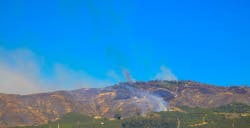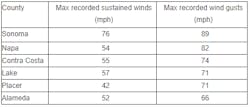PG&E Restores Power to More Than 228,000 Customers Impacted by PSPS
As of Oct. 28, 6:00 a.m., Pacific Gas and Electric Co. (PG&E) restored power to more than 228,000 of the approximately 345,000 customers impacted by the Public Safety Power Shutoff (PSPS) that started on the morning of Oct. 25. All remaining customers — approximately 117,000 — were expected to have power back on Oct. 27 or 28, late evening or early morning.
PG&E crews began restoring power to customers where no damage or hazards to electrical equipment were found during inspections that began on the morning of Oct. 26 in locations where the weather 'all clear' was received. In areas where equipment was damaged by the severe wind event, crews worked safely and as quickly as possible to make repairs and restore those customers.
PG&E meteorologists issued a weather 'all clear' for all of the areas impacted by the PSPS event, as of Oct. 27, 1:45 p.m. To fully restore service, PG&E crews needed to complete their patrols of over 17,000 miles of transmission and distribution (T&D) lines for damage or hazards.
The patrol and inspection efforts included nearly 1800 on-the-ground personnel, 65 helicopters, and one airplane. Preliminary data showed at least 13 instances of weather-related damage and hazards in the PSPS-affected areas. Examples include downed lines and vegetation on power lines. If the PG&E had not de-energized power lines, these types of damage could have caused wildfire ignitions.
The utility said restoration could be delayed for some customers in the event of significant damage to individual lines, which could be caused by wind-blown branches and other debris.
The restoration process the PG&E follows includes:
- Patrol: PG&E crews look for potential weather-related damage to lines, poles, and towers. This is done by foot, vehicle, and air.
- Repair: Where equipment damage is found, PG&E crews isolate the damaged area from the rest of the system so other parts of the system can be energized.
- Restore: Once the system is safe to energize, PG&E's Control Center can complete the process and restore power to affected areas.
- Notify customers: Customers are notified that power has been restored.
Winds in de-energized areas because of PSPS were recorded as follows:
The PG&E's goal was to have essentially all customers affected by the PSPS who could receive power restored within 12 daylight hours of the weather 'all clear' for each affected area.
The PG&E uses a PSPS only as the last resort to protect community and customer safety against wildfires, given dry and windy weather, dry vegetation, and an elevated fire risk across portions of its service area. The utility will submit a report detailing damage from the severe weather to the California Public Utilities Commission within 10 days of completion of the PSPS.
For more information, visit here.

